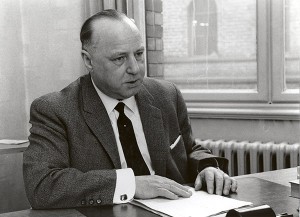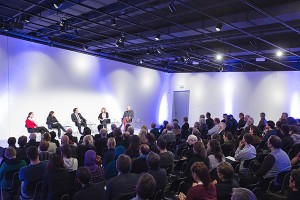… the Auschwitz Trial Began 50 Years Ago Today
On 20 December 1963, Federal Germany’s largest and longest-lasting trial to date of crimes committed in National Socialist concentration and extermination camps opened in the council chamber of Frankfurt’s Römer, the city hall. On trial were twenty-two former staff members who had worked between 1941 and 1945 at the Auschwitz concentration camp. The highest-ranking defendant and last commandant of the camp, Richard Baer, had died just before the trial began. Many others did not face charges at all, not least because almost all crimes dating from the Nazi era were already time-barred—even homicide.

Hans Hofmeyer
© Schindler‐Foto‐Report
Since the Federal German legislature had not anchored the Allies’ postwar trials in Federal German law, trial proceedings in Frankfurt am Main—and likewise all subsequent trials of Nazi crimes—were based on the Penal Code of 1871. Consequently the only charges made were those of murder, and of aiding and abetting murder; and the court, under the guidance of the presiding judge Hans Hofmeyer, was accordingly obliged to find whether defendants had been personally involved in acts of murder, that is to say, had broken the law. → continue reading
Food for Thought from Our Recent Conference on “Migration and Integration Policy Today”
In the year 2000, the UN named 18 December International Migrants’ Day. Today, thirteen years later, Germany is well-established as a prime target country for migrants. Its population is plural, multi-religious, and multi-ethnic. Migration and integration therefore provide both politicians and academics considerable scope to tread new ground. But what state is migration and integration policy in today? And what role does academia play in shaping it? Which concepts have become obsolete, and which new perspectives are opening?

Panel discussion at the Academy of the Jewish Museum Berlin
© Jewish Museum Berlin, photo: Ernst Fesseler
On 22 November 2013, experts in migration research engaged in intensive and controversial debate of these questions at a conference jointly convened by the Jewish Museum Berlin, in the framework of its new “Migration and Diversity” program, and by the German “Rat für Migration,” a nationwide network of academics specialized in migration and integration issues. In the subsequent open forum with these invited guests, politics and science met head on: politicians and academics discussed, among others, migration policies proposed by Germany’s recently elected coalition government. → continue reading

Teddy bear that belonged to Ilse Jacobson (1920-2007), textile, straw, glass, ca. 1920 to 1930, in our online collection
56,250. This is the number that comes up when I search our collection’s database for its complete holdings. 56,250 data sets describing, for the most part, individual objects, and occasionally entire mixed lots. You can now see 6,300 of these objects online. Releasing this information to the public provokes mixed feelings on the part of museum staff: we have a lot to say about many of these objects. Many of them don’t speak for themselves. You can’t tell, for instance, that this teddy bear belonged to a child emigrating from Germany. The meaning of many documents and photographs lies likewise to a large extent in their biographical or political history. They require sufficient detail and well-chosen catchwords to help visitors find other objects related to the same topic.
With this project, we have to proceed pragmatically. 15-30 minutes of working time per object is a lot if you have to inventory a mixed lot with 250 units. We verify everything, including things that occur to us as we’re working. We are aware that there’s more to write about – and there would be more to correct, – if we had the time for more thorough research. Yet we can only make forays into the library or even into the archive for special projects or particularly important objects. And so we rely to a great extent on digital sources. → continue reading


